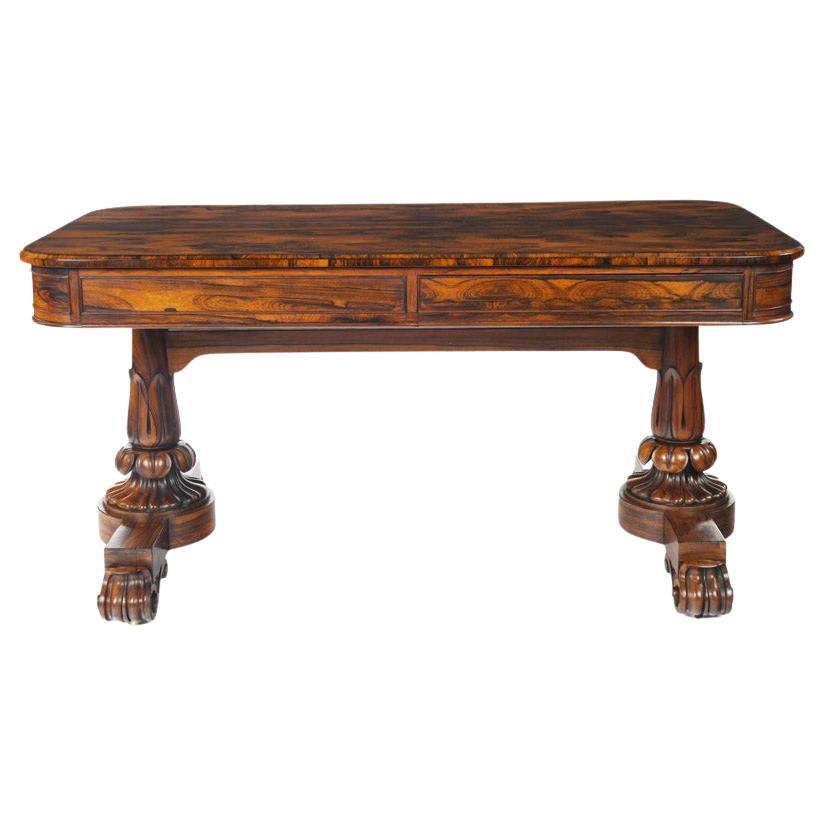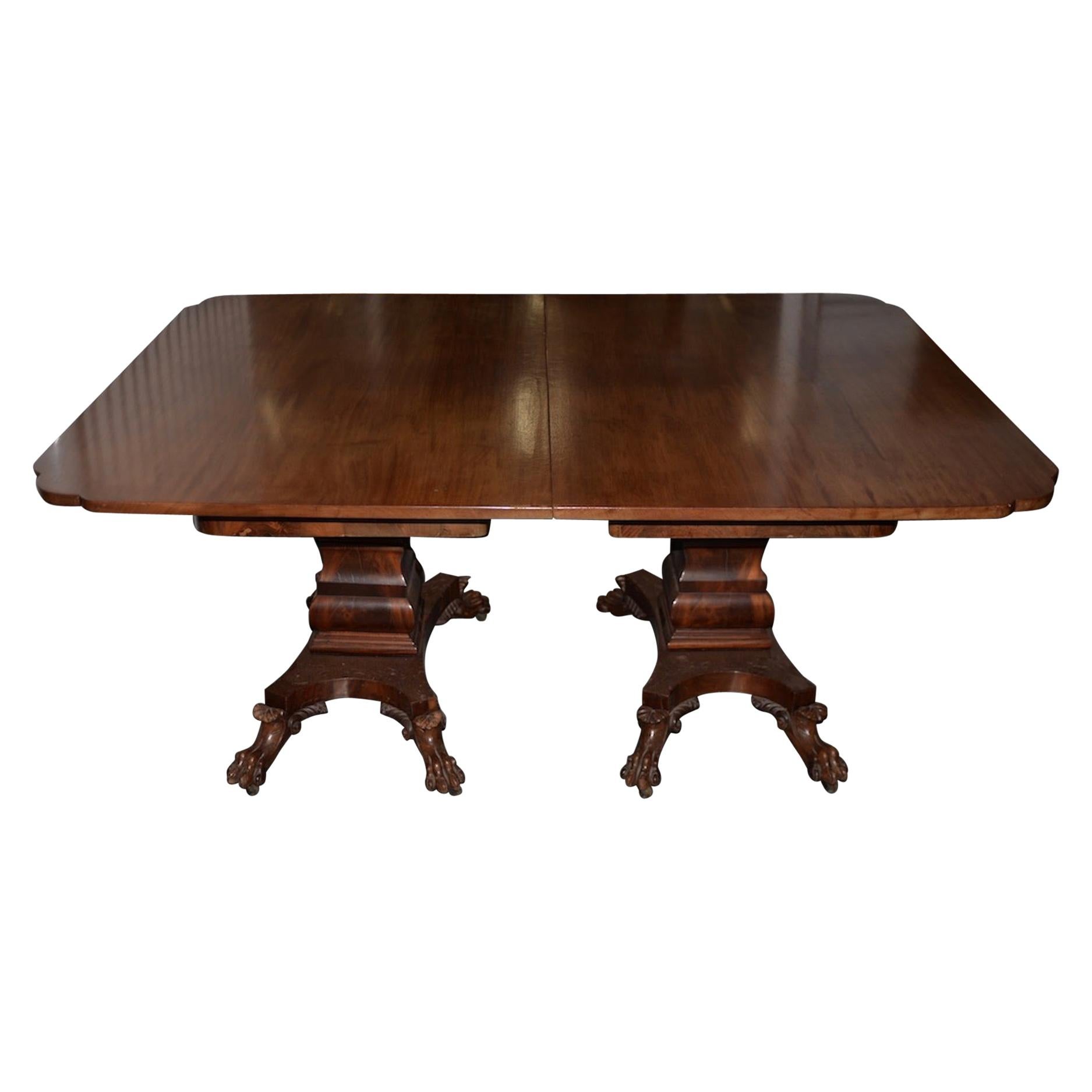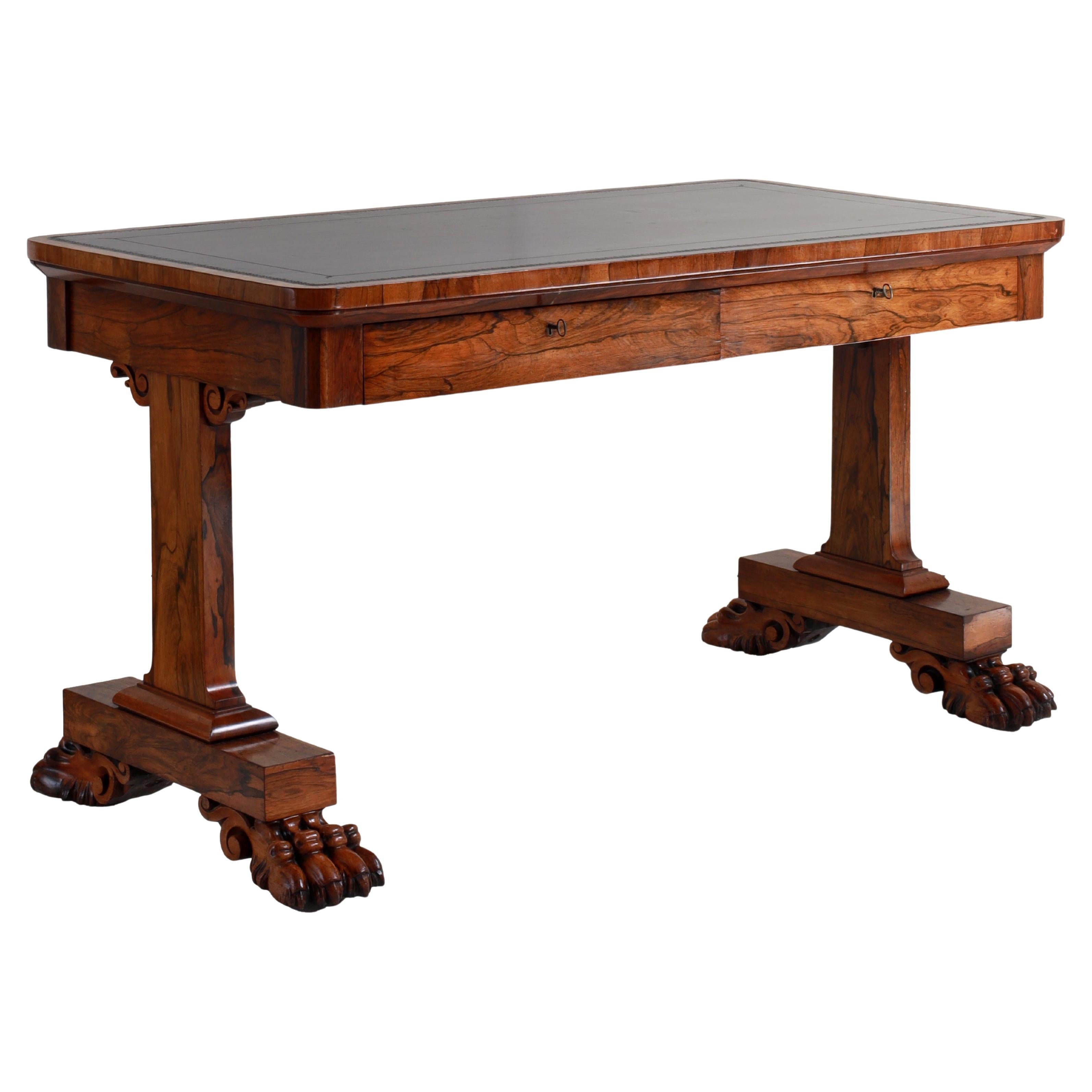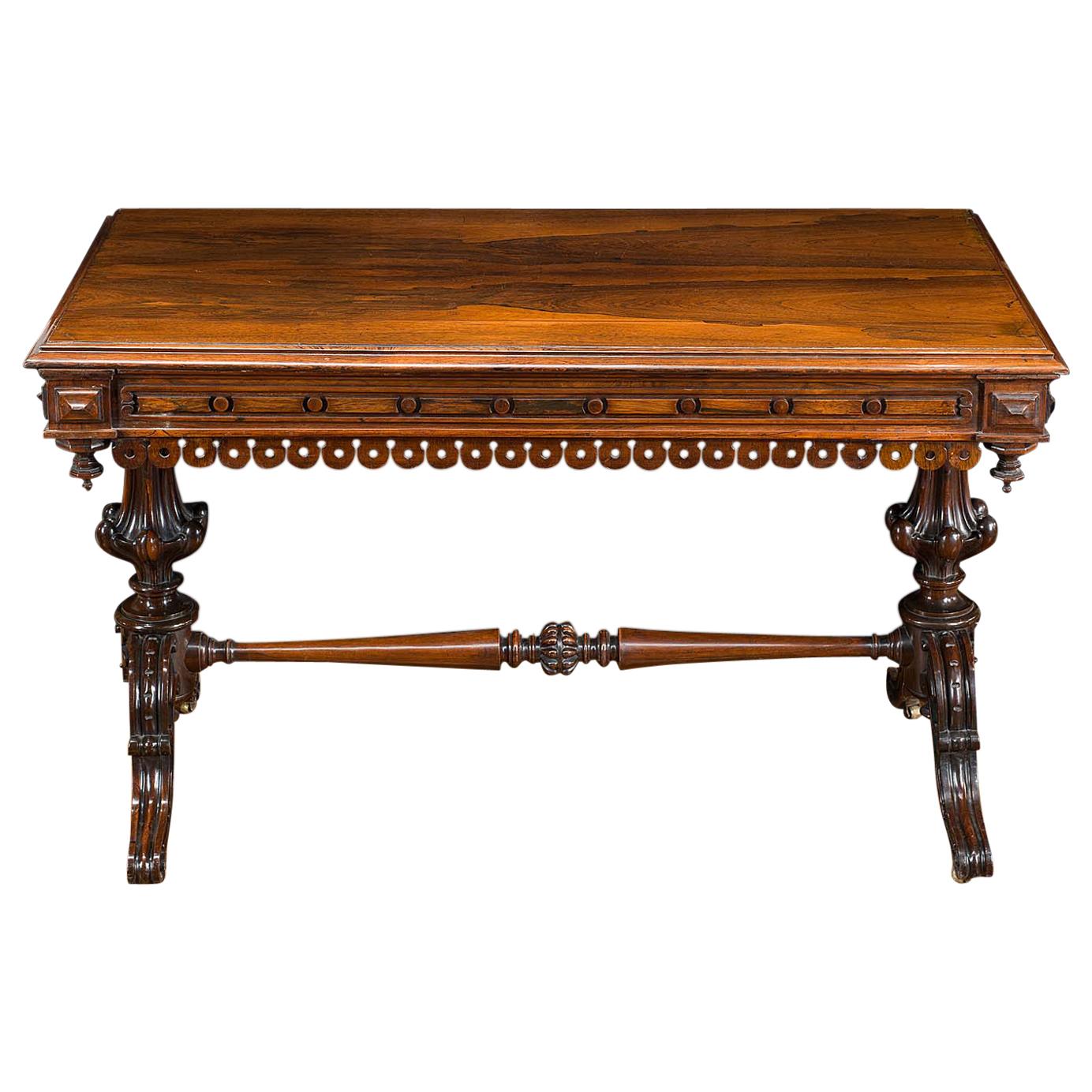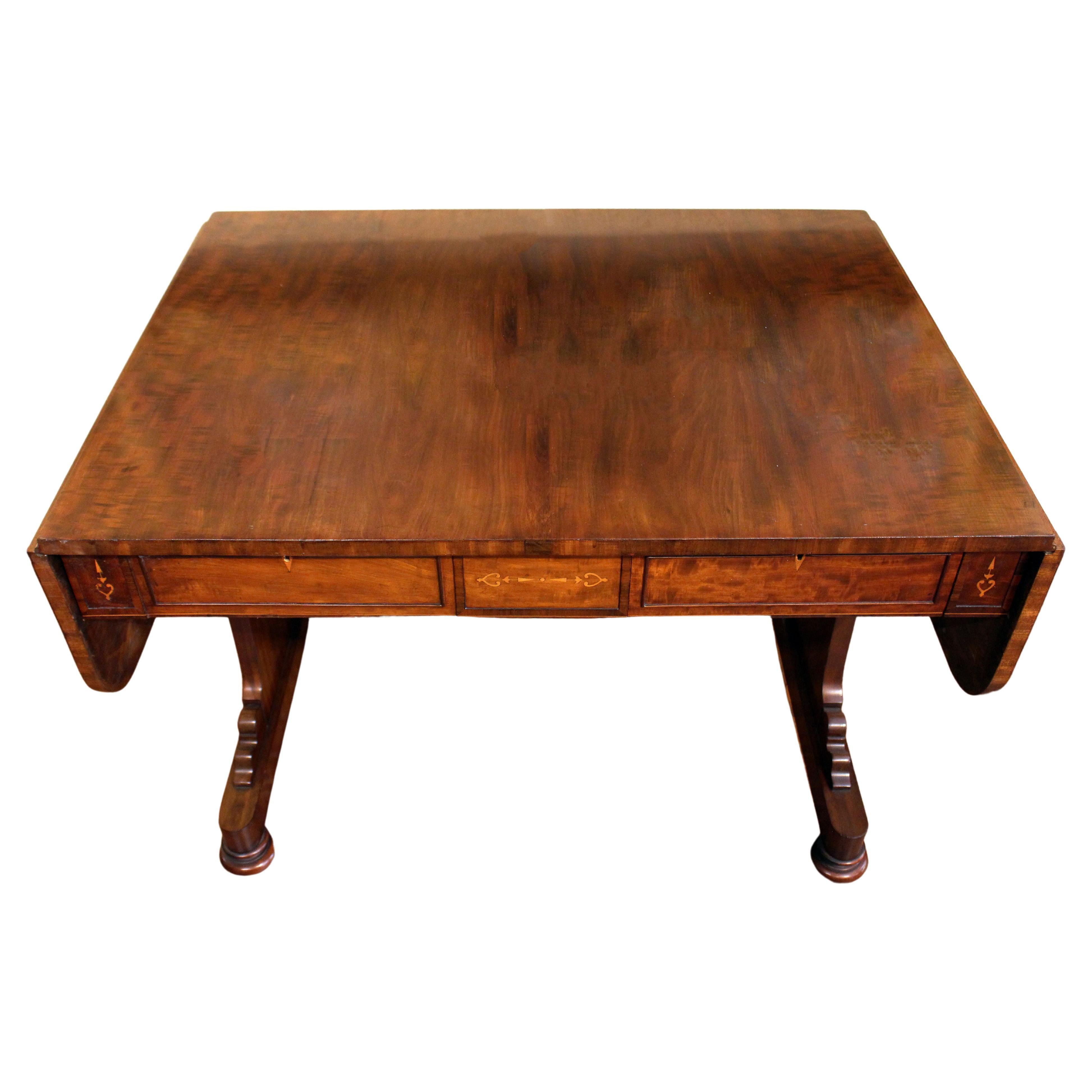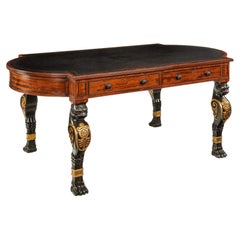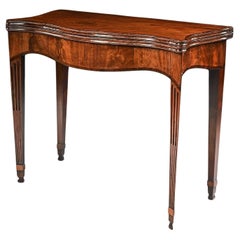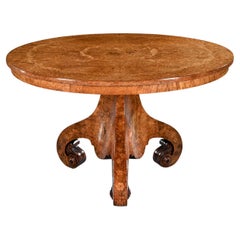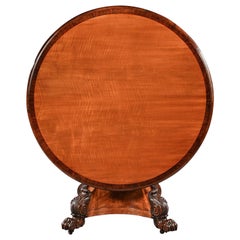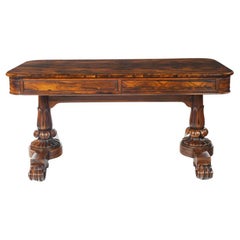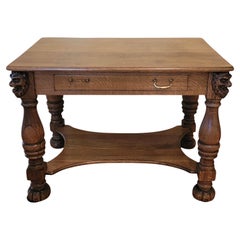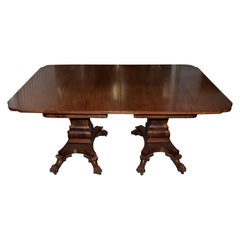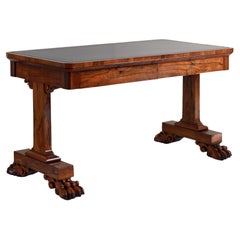Items Similar to George IV Period Rosewood Library Table With Carved Lions Paw Feet
Want more images or videos?
Request additional images or videos from the seller
1 of 7
George IV Period Rosewood Library Table With Carved Lions Paw Feet
$10,290.71
£7,500
€8,777.15
CA$14,355.31
A$15,572.27
CHF 8,188.77
MX$189,483.06
NOK 102,372.82
SEK 96,550.14
DKK 65,532.68
About the Item
A George IV Period Rosewood Library Table With Carved Lions Paw Feet
English Circa 1820- 1830
This handsome table would have been commissioned for a grand library or study. The overhanging top has rounded corners and the frieze below echoes this detail. Likewise the turned stretcher which joins the two end supports is another feature with pronounced curves. By contrast the end supports themselves are made up largely of squared corners and straight lines but they are enlivened considerably by beautifully carved winged lions paw feet and, most noticeably, lotus flower carving to the base of each support. In the frieze of the piece are two drawers with their original patinated turned wooden handles having faux drawers to the opposing side enabling this library table to stand freely within the room.
The rosewood veneers utilised throughout this piece are of extremely high quality and of fine figure, particularly those utilised on the drawer fronts and the top which have very distinctive grain. The maker has chosen to use grain with an obvious chevron-type figure on each corner of the frieze which shows a great attention to detail. This level of detail is also demonstrated by the multiple mouldings utilised on the block parts of the end supports (the sections where the feet join the table). The tops of these sections are half domed and then finished with raised central sections and all of this additional detail shows the hand of a master designer and a very talented maker.
Surviving library and writing tables usually have leather inserts in the tops and a fully veneered example such as the present piece is somewhat more unusual. This attractive and practical table is a fine example of its kind and the quality of timber used and style of decoration suggests the work of a firm such as Gillows of Lancaster.
Width: 56 inches - 142cm
Height: 29 inches - 73.5cm
Depth: 33 inches - 83.5cm
- Dimensions:Height: 28.94 in (73.5 cm)Width: 55.91 in (142 cm)Depth: 32.88 in (83.5 cm)
- Style:George IV (Of the Period)
- Materials and Techniques:
- Place of Origin:
- Period:
- Date of Manufacture:Circa 1820-1830
- Condition:Wear consistent with age and use.
- Seller Location:Benington, GB
- Reference Number:Seller: 30361stDibs: LU1183241440012
About the Seller
5.0
Gold Seller
Premium sellers maintaining a 4.3+ rating and 24-hour response times
Established in 1969
1stDibs seller since 2015
128 sales on 1stDibs
Typical response time: 1 hour
Associations
LAPADA - The Association of Arts & Antiques DealersThe British Antique Dealers' Association
- ShippingRetrieving quote...Shipping from: Benington, United Kingdom
- Return Policy
Authenticity Guarantee
In the unlikely event there’s an issue with an item’s authenticity, contact us within 1 year for a full refund. DetailsMoney-Back Guarantee
If your item is not as described, is damaged in transit, or does not arrive, contact us within 7 days for a full refund. Details24-Hour Cancellation
You have a 24-hour grace period in which to reconsider your purchase, with no questions asked.Vetted Professional Sellers
Our world-class sellers must adhere to strict standards for service and quality, maintaining the integrity of our listings.Price-Match Guarantee
If you find that a seller listed the same item for a lower price elsewhere, we’ll match it.Trusted Global Delivery
Our best-in-class carrier network provides specialized shipping options worldwide, including custom delivery.More From This Seller
View AllImportant Regency Mahogany Partners Writing Table in the Manner of George Smith
By Charles Norman, George Smith
Located in Benington, Herts
A highly Important, Regency period mahogany, ebonised and parcel-gilt partners writing table on monopodia legs of exceptional quality and design, in the manner of George Smith, stamped Chas Norman, whom was associated with the work of Gillows.
Labelled ‘Morning Room’.
English, Regency period, circa 1810-20.
Rarely seen, the crescent shaped ended rectangular top, beautifully lined with the original gilt tooled leather writing surface, enclosed by a mahogany cross-banded border and reeded edge.
The frieze, containing four finely chosen fiddle-back mahogany drawers, two pairs to opposing sides, each retaining the original gadrooned carved ebonised knob handles. The perimeters having a finely ebonised cockbead, whilst the drawer liners being executed in mahogany retain the original recessed brass locks, which look to have never been removed. Flanking the drawers are bead-moulded ebonised panels which conform to either end above a reeded mould.
Raised on four boldly designed and imposing, crisply carved, ebonised and parcel-gilt leopard monopodia supports, of wonderful original waxed condition. The Egyptian leopards mask above a bold breast decorated with carved gilt anthemion and guilloche motifs, finishing on a finely detailed carved leg and paw foot.
The condition is excellent, retaining the original hand-dyed and gilt tooled waxed leather writing surface along with original locks, handles and ebonising with gilt-work to the legs. Commissioned for what presumes to be a private collection and due to its condition, being obvious to see, this writing table has been home to an important household. Labelled ‘Morning Library’ to the underside, whilst in this exemplary condition strongly suggests this striking piece of Regency furniture has furnished the library of the said house for the majority of its life.
As can be noted, this is an extremely rare, elegant, early Regency writing table of exceptional colour, which corresponds with designs of the celebrated furniture maker and designer George Smith, workmanship of Gillows, being stamped to the underside Chas Norman four times.
George Smith (1756 - 1826) was one of the most influential furniture designers of the English Regency Period (1811-1830). Smith, who began his pattern-book in 1804, wrote of ‘the great taste and elegance’ of this design.
In 1808 he published his influential and definitive text on Regency interior Design titled ‘ A Collection of Designs for Household Furniture and Interior Decoration’ and classed himself as ‘Upholder Extraordinary to His Royal Excellency the Prince of Wales’…The Prince Regent.
Smith was inspired in his designs from his earlier career as an Egyptologist, producing drawings incorporating motifs of Leopards heads and paws, Lions, sphinx’s, anthemia, and griffons amongst others.
Charles Heathcote Tatham (1772-1842) published ‘Etchings, Representing the Best Examples of Ancient Ornamental Architecture; Drawn from the Originals in Rome, and Other Parts of Italy During the Years 1794, 1795, and 1796’, in which he illustrated an antique tripod table...
Category
Antique Early 19th Century British Regency Desks and Writing Tables
Materials
Mahogany, Giltwood
$28,813 Sale Price
50% Off
George III Mahogany Serpentine Tea Table of Exceptional Colour and Patination
Located in Benington, Herts
A Very Fine and Unusual George III Period Mahogany Serpentine Tea Table of Exceptional Colour and Patina
English c.1780
This fine table is a riot of serpentine curves. Broadly spe...
Category
Antique Late 18th Century English George III Tables
Materials
Serpentine
Fine Burl Amboyna and Marquetry Centre Table Attributed to George Blake and Co a
By George Blake & Co.
Located in Benington, Herts
A Fine Burl Amboyna and Marquetry Centre Table Attributed to George Blake and Co and Probably Retailed by Edward Holmes Baldock
English London made Circa 1845.
An exceptional table of wonderful colour, utilising the finest amboyna veneers as a background for a complex pattern of floral marquetry on the stem, feet and table top.
The tilt-top with segmented veneers and central floral inlay within an inlaid floral scroll surround and with a conforming inlaid outer border. The triform pedestal base with foliate inlay, carved leaf scroll feet with carved lateral flower head roundels with recessed castors.
The basic design for this table comes from the work of the designer Richard Bridgens and was published in 1838 as plate 16 in his Furniture with Candelabra.
As can be seen from the image of Bridgens' design, the outer scrolling border on the top of our table is very much in the style of that suggested in the design but the other marquetry is of a sophisticated floral type popularised slightly later, suggesting a date of c.1845 for our table. Marquetry of this sort was a speciality of the Blake family, marquetry experts and associates of the great dealer Edward Holmes Baldock. Baldock was responsible for building some museum quality collections of fine 18th century French furniture during this period for some of his famous aristocratic clients but he also supplied new furniture in the French taste, often incorporating marquetry by the Blake firm. The use of exotic amboyna as the ground for this marquetry is also in keeping with other pieces known to have been supplied by Baldock, for whom it appears only the best was good enough.
The sinuous lines of this table and the exotic veneers give the piece a more timeless feel than many other examples from this period and the colour means that it would work equally well in a contemporary interior or alongside pieces of Art Deco furniture as it would in a more traditional room. This is a piece of sublime quality that somehow manages to be both decorative and yet understated and as such is exactly the sort of piece we enjoy sharing with our clients.
Edward Holmes Baldock (1777-1845)
Born on the 14th May 1777 he established his business in 1805 in Hanway Street which over the years he expanded at this location. He soon was a prominent London furniture dealer to several members of the Royal Family and is responsible for supplying French-fashioned furniture to the 5th Duke of Buccleuch.
Edwards Holmes Baldock’s pieces have become a prized possession amongst collectors, museums and dealers alike. The use of a variety of specimen woods can often been seen on attributed and signed tables by Edward Holmes Baldock, reminiscent of those on the present table. Baldock was thought to have worked very closely to with the master of marquetry and inlay of the 19th Century Robert Blake who had workshops adjacent to Baldock’s retail premises.
Pieces in public collections with likely links to the Blake Family include a piano in the Metropolitan Museum of Art, a writing desk in Goodwood House, a centre table in Syon House, a circular table in Alnwick Castle, an octagonal table in the Leeds City Art Gallery at Temple Newsam House and also signed works in the Victoria and Albert Museum.
Baldock's works often imitated the important pieces of 18th-century French furniture that Francophile collectors including George, Prince of Wales, later George IV, William Beckford, Francis Seymour Conway, 3rd Marquess of Hertford and George Watson...
Category
Antique 1840s English Center Tables
Materials
Burl, Amboyna
Rare 19th Century Peters of Genoa Satinwood & Rosewood Centre Table
By Henry Thomas Peters
Located in Benington, Herts
A rare and finely constructed circular satinwood centre table most probably by Henry Thomas Peters of Genoa.
Italy Circa 1830.
The circular tilt top having a finely chosen cuts of book-matched West Indian satinwood veneer with a rosewood banded and moulded edge over a splayed in-curved quatroform base, terminating on four acanthus carved scrolled rosewood lions paw feet raised on brass castors.
A very fine table with wide cuts of satinwood which would have been extremely expensive in the early 19th Century. Inspired by the French Empire design as viewed through the lens of English Regency, in particular the designs of Thomas Hope of 1807, along with the construction all point to Henry Thomas Peters being the maker, active in Genova around 1820 to 1850, being one of the leading cabinet makers of the period obtaining the title of ‘cabinetmaker of his Majesty’.
Henry Thomas Peters’ English antecedents remain obscure although he probably began his career in England. However, he is not listed in Beard and Gilbert’s Dictionary of English Furniture Makers 1660-1840. He arrived in Genoa in circa 1817, and by 1824 had established a workshop in Via Balbi, a neighbourhood in which the Royal Palace and other noble residences were located; today some of his works are preserved in the Palazzo Rosso, Genoa and were probably bequests from the various aristocratic families for whom he worked, including the Brignole Sale family.
Peters was appointed by the Court of Savoy and produced furniture for their palaces in Turin, Genoa and Racconigi including the Palazzo Reale. Notably, in 1841, furniture for the wedding of Prince Vittorio Emanuele. In 1846, Peters and his extensive workshop won the silver medal at the Esposizione dei Prodotti e delle Manifatture Nazionali. As pointed out Peters was famed for producing furniture with the technical accuracy typical of English but adapted to the late Italian Empire style.
A set of six Italian Giltwood...
Category
Antique 19th Century Italian Center Tables
Materials
Rosewood, Satinwood
An Extremely Fine Rosewood and Brass Inlaid Writing Table Attributed To Gillows
By Gillows of Lancaster & London
Located in Benington, Herts
An Extremely Fine and rare Rosewood and Brass Inlaid Writing Table Attributed to the Oxford Street Workshop of Gillows.
English c.1820-1830
With a raised back comprising a thre...
Category
Antique Early 19th Century English Desks and Writing Tables
Materials
Brass
Exceptional Early 17th Century Spanish Walnut Vargueno Desk on Stand
Located in Benington, Herts
An exceptionally fine example of an early 17th Century Spanish renaissance walnut vargueno / bargueno escritorio writing desk on trestle stand.
Sp...
Category
Antique 17th Century Spanish Renaissance Desks and Writing Tables
Materials
Walnut
You May Also Like
Fine William IV Period Rosewood Library Table by George Simson and Son
Located in Lymington, Hampshire
Fine William IV Period Rosewood Library Table by George Simson and Son of St Paul’s Churchyard, London, c.1837.
The finely shaped rectangular top with rounded corners, supported on ...
Category
Antique 19th Century English William IV Tables
Materials
Rosewood
Antique American Oak Library Table With Carved Lion’s Heads, Late 19th–Early 20t
Located in North Palm Beach, FL
This antique library table, crafted from solid American oak, reflects the bold elegance of Renaissance and Jacobean Revival design from the late 19th to early 20th century.
The rect...
Category
Antique Late 19th Century American Renaissance Revival Tables
Materials
Brass
William IV Mahogany Dining Table with Lions Paw Feet, 19th Century
Located in San Francisco, CA
William IV mahogany dining table with lions paw feet, 19th century.
Exceptionally well built late 19th century mahogany dining table.
This ...
Category
Antique Early 19th Century English William IV Dining Room Tables
Materials
Mahogany
William IV Rosewood Library Table
Located in London, GB
A distinguished William IV period library table in richly figured rosewood, featuring bold architectural lines, intricate detailing and a black leather writing surface, finely tooled...
Category
Antique Early 18th Century British William IV Tables
Materials
Leather, Rosewood
Rosewood 19th Century Library Hall Table
Located in London, GB
A fine, early 19th century rosewood library table in the manner of the architect and designer Richard Bridgens (1785-1846). The finely figured top with a moulded edge above a carved ...
Category
Antique 1840s English Early Victorian Tables
Materials
Rosewood
Early 19th Century English Mahogany Sofa Table
Located in Chapel Hill, NC
Circa 1820s sofa table in plum pudding mahogany with boxwood inlays and escutcheons. English, George IV. Opposing faux and functioning drawers. Sleek lines...
Category
Antique Early 19th Century English George IV Sofa Tables
Materials
Wood
$1,800 Sale Price
35% Off
More Ways To Browse
Lion Feet Library Table
Os De Mouton Table
Outdoor Side Table Used
Pace Pac Man
Pace Spiral Table
Pair Of Syrian Tables
Pawn Marble Side Table
Perone Side Table
Pierre Jeanneret Bedside Table
Pk 62
Promemoria Battista
Raw Edge Side Table
Reclaimed Green Tiles
Regency Wash Stand
Reproduction Side Table
Retro Hammary End Table
Round Bobbin Table
Sabine Marceli Candy Columns
